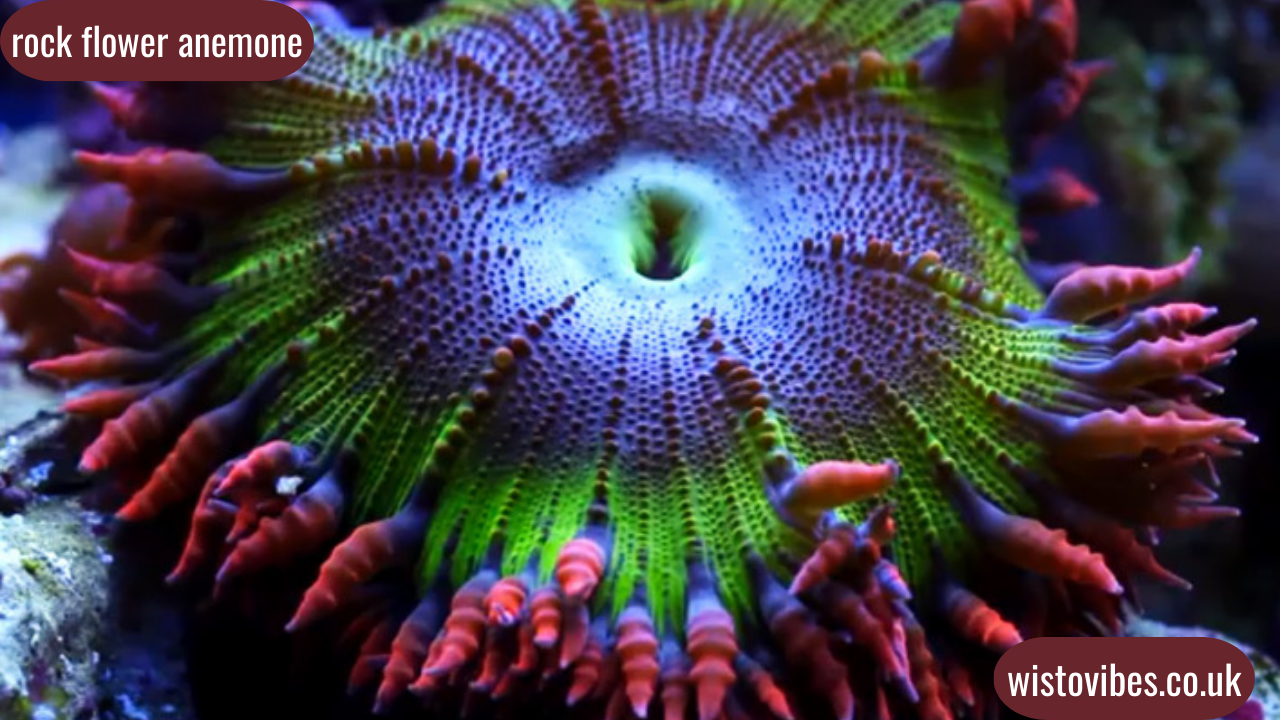The world of marine life is dazzling and complex, but few creatures capture the attention of aquarists and reef hobbyists quite like the rock flower anemone. With its radiant colors, manageable temperament, and intriguing behavior, this anemone species—often referred to as the rockflower anemone—has become a staple in saltwater aquariums. But what is a rock flower anemone?? Why has it gained such popularity in the aquarium community? And what does it take to care for one successfully? In this detailed guide, we explore everything you need to know about this fascinating marine invertebrate.
Introduction to the Rock Flower Anemone
The rock flower anemone, scientifically known as Phymanthus crucifer, hails from the tropical Atlantic and Caribbean waters. Despite their relatively modest size, these creatures are anything but dull. With their fleshy tentacles, vivid coloration, and disc-like bodies, rock flower anemones are often mistaken for corals.
But make no mistake—this is a true anemone species. Unlike its more aggressive cousins like the carpet anemone, the rock flower anemone is a peaceful and stationary inhabitant, making it a fantastic choice for both novice and advanced reef aquarists.
What Makes the Rock Flower Anemone So Special??
The rock flower anemone?? It’s not just the name that draws interest. Their exceptional patterns and electric hues—ranging from neon greens to deep purples and fiery oranges—create a kaleidoscopic display that instantly becomes the centerpiece of any reef tank.
In addition to their appearance, rockflower anemones boast a unique adaptability. They are hardy, non-invasive, and unlikely to roam the tank, which means they won’t sting or disrupt neighboring corals or invertebrates. That reliability makes them a highly sought-after addition to peaceful community tanks.
Ideal Tank Conditions for a Rockflower Anemone
Successfully keeping a rock flower anemone begins with understanding its ideal environment. Although hardy, providing proper conditions ensures longevity and vibrancy.
1. Tank Size
While rock flower anemones don’t require massive tanks, a minimum of 10 gallons is suggested. More space allows better water stability and compatibility with other species.
2. Water Parameters
These anemones thrive in stable, high-quality saltwater with the following parameters:
- Temperature: 72°F to 78°F
- Salinity: 1.024–1.026
- pH: 8.1–8.4
- Nitrates: <5 ppm
- Calcium: 400–450 ppm
3. Lighting and Flow
Moderate to strong lighting helps enhance their coloration and overall health. While they can adapt to lower lighting, they flourish under LED reef lighting systems. Moderate water flow is ideal—too strong, and their delicate bodies may be harmed.
4. Substrate and Placement
Rock flower anemones prefer coarse substrate or rocky crevices where they can firmly anchor their foot. Once they settle, they tend to stay put, adding stability to your aquascape.
Feeding and Nutrition for Rock Flower Anemone
Although rockflower anemones receive a good portion of their nutrition through photosynthesis via symbiotic zooxanthellae (algae living in their tissues), supplemental feeding can greatly enhance growth and coloration.
Feed them 1–2 times a week with:
- Mysis shrimp
- Brine shrimp
- Finely chopped seafood
- High-quality frozen reef blends
Use feeding tongs or a turkey baster to deliver food directly to the oral disc. Be mindful not to overfeed—excess food can decay and compromise water quality.
Compatibility: What Can Live with a Rock Flower Anemone??
A common question asked is: what can live with a rock flower anemone?? Fortunately, this peaceful species coexists well with many reef tank inhabitants.
Compatible Tankmates Include:
- Clownfish (though they typically don’t host in rock flower anemones)
- Gobies and blennies
- Soft and LPS corals
- Cleaner shrimp and small invertebrates
Avoid:
- Butterflyfish or large angelfish that may nip at anemones
- Predatory crabs
- Aggressive or territorial fish that may disturb the anemone
Even though these anemones don’t tend to move around, maintaining some distance from delicate corals is wise to prevent accidental stings.
Reproduction and Propagation
In the right conditions, rock flower anemones will reproduce in the aquarium. They are known to propagate both sexually and asexually, although asexual reproduction (splitting) is more common in captivity.
Signs of propagation include:
- Visible budding from the base
- Slight division along the mouth
- Temporary reduced feeding or retraction
A healthy, stress-free environment boosts chances of propagation. Hobbyists often collect multiple color morphs to create vibrant “anemone gardens.”
Common Issues with Rock Flower Anemones
Even though they are low-maintenance compared to other anemones, a few challenges can arise.
1. Bleaching
Just like corals, rockflower anemones can bleach if lighting is too intense or water conditions deteriorate. A bleached anemone appears pale or white.
2. Wandering
Though rare, some anemones may wander if conditions aren’t right. Reevaluate flow, lighting, and substrate if this occurs.
3. Pests and Predators
Always quarantine new tank mates and corals to avoid introducing pests like aiptasia, flatworms, or parasitic snails that can harm anemones.
Buying Tips: Selecting a Healthy Rock Flower Anemone
When choosing your rock flower anemone??, examine the following:
- Color vibrancy: A bright, colorful anemone is usually healthy.
- Oral disc: Should be centered and closed when not feeding.
- Foot attachment: A firmly attached foot signals strength and stability.
- No visible tears or damage to tentacles.
It’s also recommended to acclimate your new anemone slowly to your tank’s temperature and salinity levels using the drip method to reduce stress.
The Rise in Popularity of Rockflower Anemones
The growing fascination with rock flower anemones among reef keepers isn’t surprising. With their kaleidoscopic display, ease of care, and peaceful temperament, these anemones appeal to aquarists seeking both beauty and simplicity.
Their availability in various color morphs has also created a collector’s market. From “Ultra Rainbow” to “Metallic Red,” these variants are increasingly sought after to add flair and movement to reef tanks.
FAQs About Rock Flower Anemone
Q: Will clownfish host in rock flower anemones??
A: It’s possible, but rare. Clownfish typically prefer species like bubble tip anemones. However, some clownfish may choose to associate with a rockflower anemone out of comfort.
Q: Can I keep multiple rock flower anemones together??
A: Absolutely! They don’t mind being near each other and often form colorful colonies. Just ensure enough space and food.
Q: Do rock flower anemones need special lighting??
A: Moderate to high-quality LED lighting is ideal. While they can survive in lower light, their colors shine brightest under reef lighting.
Q: How often should I feed my rockflower anemone??
A: Once or twice a week is sufficient. Overfeeding can lead to poor water quality.
Q: What’s the lifespan of a rock flower anemone??
A: With proper care, they can live several years in captivity—some hobbyists report lifespans exceeding five years.
Final Thoughts on the Rock Flower Anemone??
The rock flower anemone?? is a fascinating, beautiful, and manageable addition to any saltwater aquarium. Whether you’re an experienced aquarist or a beginner intrigued by the vibrant life of a reef tank, the rockflower anemone provides visual excitement and low-maintenance care.
Their non-aggressive nature, striking appearance, and ability to stay in place make them ideal for aquascaping and even reef-safe community tanks. With the right conditions, regular care, and a bit of patience, you’ll find that the rock flower anemone is not only easy to keep but endlessly captivating.




